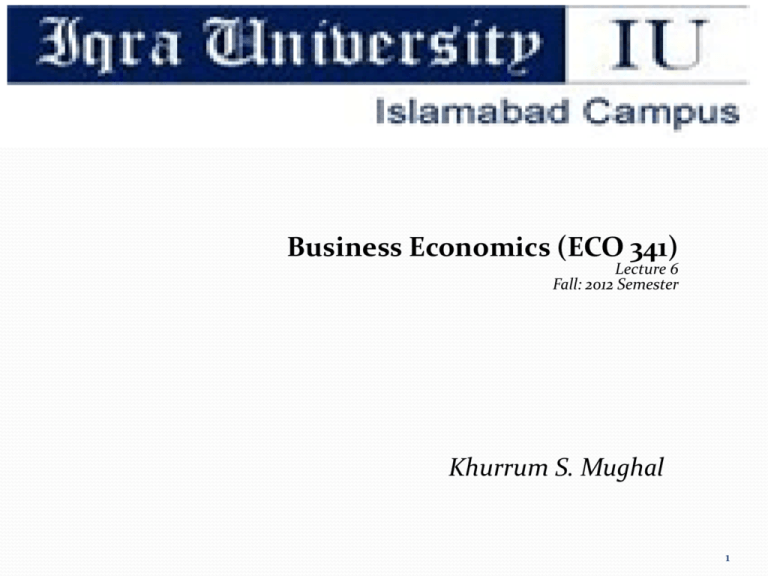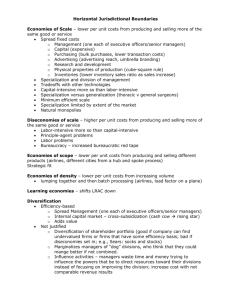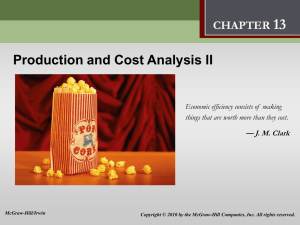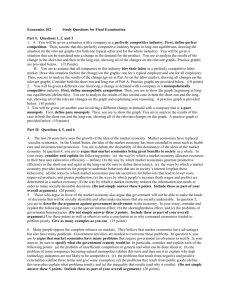Business Economics Lecture 6
advertisement

Business Economics (ECO 341) Lecture 6 Fall: 2012 Semester Khurrum S. Mughal 1 Theme of the Lecture Cost Theory & Analysis Short-Run Cost Function Link Between Production and Cost Least Cost Rule Economic Concept of Cost Economies of Scale Diseconomies of Scale Revenue Analysis 2 Short-Run A period of time so short that the firm cannot alter the quantity of some of its inputs Typically plant and equipment are fixed inputs in the short run Fixed inputs determine the scale of the firm’s operation 3 Short-Run Cost Functions Total Cost = TC = f(Q) Total Fixed Cost = TFC Total Variable Cost = TVC TC = TFC + TVC 4 Short-Run Cost Functions Q TFC TVC TC 0 60 0 60 1 60 20 80 2 60 30 90 3 60 45 105 4 60 80 140 5 60 135 195 5 Short-Run Cost Functions TFC 6 Short-Run Cost Functions Average Total Cost = ATC = TC/Q Average Fixed Cost = AFC = TFC/Q Average Variable Cost = AVC = TVC/Q ATC = AFC + AVC Marginal Cost = TC/Q = TVC/Q 7 Short-Run Cost Functions Q TFC TVC TC AFC AVC ATC MC 0 60 0 60 - - - - 1 60 20 80 ? ? ? ? 2 60 30 90 ? ? ? ? 3 60 45 105 ? ? ? ? 4 60 80 140 ? ? ? ? 5 60 135 195 ? ? ? ? 8 Short-Run Cost Functions Q TFC TVC TC AFC AVC ATC MC 0 60 0 60 - - - - 1 60 20 80 60 20 80 20 2 60 30 90 30 15 45 10 3 60 45 105 20 15 35 15 4 60 80 140 15 20 35 35 5 60 135 195 12 27 39 55 9 Short-Run Cost Functions 10 11 Theme of the Lecture Cost Theory & Analysis Short-Run Cost Function Link Between Production and Cost Least Cost Rule Economic Concept of Cost Economies of Scale Diseconomies of Scale Revenue Analysis 12 The Link Between Production and Cost The cost curves are derived from the Prices of factors of production (Inputs) Production Function What are diminishing returns to factors? The cost curves are U-Shaped. Why? 13 14 Theme of the Lecture Cost Theory & Analysis Short-Run Cost Function Link Between Production and Cost Least Cost Rule Economic Concept of Cost Economies of Scale Diseconomies of Scale Revenue Analysis 15 Choice of Inputs by the Firm Marginal Product and the least-cost rule Marginal Product of a factor divided by the factor price MPL = MPK ………….. w r Marginal product per dollar of input Substitution Rule: when price of a factor changes 16 Theme of the Lecture Cost Theory & Analysis Short-Run Cost Function Link Between Production and Cost Least Cost Rule Economic Concept of Cost Economies of Scale Diseconomies of Scale Revenue Analysis 17 Economic Concept of Cost Opportunity costs are the value of the other products that the resources used in production could have produced at their next best alternative 18 Theme of the Lecture Cost Theory & Analysis Short-Run Cost Function Link Between Production and Cost Least Cost Rule Economic Concept of Cost Economies of Scale Diseconomies of Scale Revenue Analysis 19 Economies of Scale Economies of scale refers to the phenomena of decreased per unit cost as the number of units of production increase. The initial investment in capital is diffused with reduction in marginal cost of producing Economies of scale means a reduction in the per unit costs of a product as a firm's production increases. Economies of Scale Tend to occur in industries with high capital costs Types of economies of scale: Internal Economies of scale External Economies of scale Internal Economies of Scale Result of mass production. As the firm produces more and more goods, the average cost begin to fall because of: Technical economies made in the actual production of the good. For example, large firms can use expensive machinery, intensively. Managerial economies made in the administration of a large firm by splitting up management jobs and employing specialist accountants, salesmen, etc. Financial economies made by borrowing money at lower rates of interest than smaller firms. Internal Economies of Scale Marketing economies made by spreading the high cost of advertising on television and in national newspapers, across a large level of output. Commercial economies made when buying supplies in bulk and therefore gaining a larger discount. Research and development economies made when developing new and better products. External Economies of Scale These are economies made outside the firm as a result of its location, and occur when: A local skilled labour force is available. Specialist, and local back-up firms can supply parts or services. An area has a good transportation network. An area has an excellent reputation for producing a particular good. For example…………. Economies of Scale Unit Cost Scale A 82p Scale B 54p LRAC Output Theme of the Lecture Cost Theory & Analysis Short-Run Cost Function Link Between Production and Cost Least Cost Rule Economic Concept of Cost Economies of Scale Diseconomies of Scale Revenue Analysis 26 The other side As with all things, as industries get bigger so does the infrastructure and the problems associated with economies of scale. This can result in: Internal Diseconomies of Scale External Diseconomies of Scale Internal Diseconomies of Scale As the firm increases production, after some point average costs begin to rise because: The disadvantages of the division of labour take effect- too many people doing different jobs add to costs. Management becomes out of touch with the shop floor and some machinery becomes over-manned- costs increase. Decisions are not taken quickly and there is too much formalities. Lack of communication in a large firm means that management tasks sometimes get done twice. Poor labour relations may develop in large companies. External Diseconomies of Scale These occur when too many firms have located in one area. Unit costs begin to rise because: Local labour becomes scarce and firms now have to offer higher wages to attract new workers. Land and factories become scarce and rents begin to rise. Local roads become congested and so transportation costs begin to rise. Theme of the Lecture Cost Theory & Analysis Short-Run Cost Function Link Between Production and Cost Least Cost Rule Economic Concept of Cost Economies of Scale Diseconomies of Scale Revenue Analysis 30 Revenue Analysis Revenue (or turnover) is the income generated from the sale of output in product markets. There are two main revenue concepts to grasp at this stage: Average Revenue (AR) = Price per unit = total revenue / output Marginal Revenue (MR) = the change in revenue from selling one extra unit of output Revenue Analysis Price per unit (average revenue) £s Quantity Demanded (Qd) Total Revenue (TR) Marginal Revenue (MR) units £s £s 400 220 88000 370 340 125800 315 340 460 156400 255 310 580 179800 195 280 700 196000 135 250 820 205000 75 220 940 206800 15 190 1060 201400 -45 Revenue Analysis








